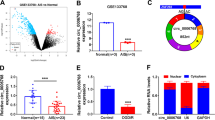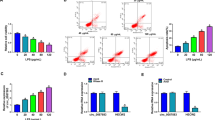Abstract
Brain microvascular endothelial cells (BMECs) injury is one of the main causes of cerebrovascular diseases. Circular RNA (circRNA) has been found to be involved in the regulation of cerebrovascular diseases progression. However, the role and mechanism of circ_0003423 in cerebrovascular diseases is still unclear. In our study, oxidized low density lipoprotein (ox-LDL)-induced HBMEC-IM cells were used to construct cerebrovascular cell injury model in vitro. Quantitative real-time PCR was used to determine the expression levels of circ_0003423, miR-589-5p and Ten-eleven translocation 2 (TET2). The interactions between miR-589-5p and circ_0003423 or TET2 were confirmed by dual-luciferase reporter assay, RIP assay and RNA pull-down assay. Cell viability, angiogenesis and apoptosis were measured using cell counting kit 8 assay, tube formation assay and flow cytometry. Cell oxidative stress was evaluated by detecting the levels of reactive oxygen species and lactate dehydrogenase. The protein levels were examined by western blot analysis. Our results showed that circ_0003423 was a downregulated circRNA in ox-LDL-induced HBMEC-IM cells. In the terms of mechanism, circ_0003423 was found to be a sponge of miR-589-5p. Function analysis showed that circ_0003423 overexpression could relieve ox-LDL-induced HBMEC-IM cell injury, and this effect could be reversed by miR-589-5p mimic. In addition, TET2 was confirmed to be a target of miR-589-5p, and its overexpression could alleviate ox-LDL-induced HBMEC-IM cell injury. Moreover, the rescue experiments also confirmed that TET2 silencing could abolish the inhibition effect of anti-miR-589-5p on ox-LDL-induced HBMEC-IM cell injury. In summary, our data showed that circ_0003423 alleviated ox-LDL-induced HBMEC-IM cells injury through regulating the miR-589-5p/TET2 axis.







Similar content being viewed by others
References
Leo LM, Hoang FB, Smith M, Lindenau R, Sporici K, Brailoiu KT, Abood E, Brailoiu ME (2019) GPR55-mediated effects on brain microvascular endothelial cells and the blood–brain barrier. Neuroscience 414:88–98
Helms HC, Abbott NJ, Burek M, Cecchelli R, Couraud PO, Deli MA, Forster C, Galla HJ, Romero IA, Shusta EV, Stebbins MJ, Vandenhaute E, Weksler B, Brodin B (2016) In vitro models of the blood–brain barrier: an overview of commonly used brain endothelial cell culture models and guidelines for their use. J Cereb Blood Flow Metab 36:862–890
Abdullahi W, Tripathi D, Ronaldson PT (2018) Blood–brain barrier dysfunction in ischemic stroke: targeting tight junctions and transporters for vascular protection. Am J Physiol Cell Physiol 315:C343–C356
Peeyush Kumar T, McBride DW, Dash PK, Matsumura K, Rubi A, Blackburn SL (2019) Endothelial cell dysfunction and injury in subarachnoid hemorrhage. Mol Neurobiol 56:1992–2006
Scicchitano P, Cortese F, Gesualdo M, De Palo M, Massari F, Giordano P, Ciccone MM (2019) The role of endothelial dysfunction and oxidative stress in cerebrovascular diseases. Free Radic Res 53:579–595
Shekhar S, Cunningham MW, Pabbidi MR, Wang S, Booz GW, Fan F (2018) Targeting vascular inflammation in ischemic stroke: recent developments on novel immunomodulatory approaches. Eur J Pharmacol 833:531–544
Nan D, Jin H, Deng J, Yu W, Liu R, Sun W, Huang Y (2019) Cilostazol ameliorates ischemia/reperfusion-induced tight junction disruption in brain endothelial cells by inhibiting endoplasmic reticulum stress. FASEB J 33:10152–10164
Kristensen LS, Andersen MS, Stagsted LVW, Ebbesen KK, Hansen TB (2019) The biogenesis, biology and characterization of circular RNAs. Nat Rev Genet 20:675–691
Zhang Z, Yang T, Xiao J (2018) Circular RNAs: promising biomarkers for human diseases. EBioMedicine 34:267–274
Hansen TB, Jensen TI, Clausen BH, Bramsen JB, Finsen B, Damgaard CK, Kjems J (2013) Natural RNA circles function as efficient microRNA sponges. Nature 495:384–388
Bai Y, Zhang Y, Han B, Yang L, Chen X, Huang R, Wu F, Chao J, Liu P, Hu G, Zhang JH, Yao H (2018) Circular RNA DLGAP4 ameliorates ischemic stroke outcomes by targeting miR-143 to regulate endothelial-mesenchymal transition associated with blood–brain barrier integrity. J Neurosci 38:32–50
Wu F, Wu HB, Yang S, Leng L, Li S, Liao M, Wang J, Ye G, Zhang Q, Chen Y, Chen H, Zhong X, Xu M, Liu Y, Zhang Q, Yao JH (2019) Circular RNA TLK1 aggravates neuronal injury and neurological deficits after ischemic stroke via miR-335-3p/TIPARP. J Neurosci 39:7369–7393
Xu X, Wu Z, Qiu H, Wu J (2021) Circular RNA circPHC3 promotes cell death and apoptosis in human BMECs after oxygen glucose deprivation via miR-455-5p/TRAF3 axis in vitro. Neuropsychiatr Dis Treat 17:147–156
Dong Y, Fan X, Wang Z, Zhang L, Guo S (2020) Circ_HECW2 functions as a miR-30e-5p sponge to regulate LPS-induced endothelial-mesenchymal transition by mediating NEGR1 expression. Brain Res 1748:147114
Li CY, Ma L, Yu B (2017) Circular RNA hsa_circ_0003575 regulates oxLDL induced vascular endothelial cells proliferation and angiogenesis. Biomed Pharmacother 95:1514–1519
Sacco RL, Rundek T (2012) Cerebrovascular disease. Curr Opin Neurol 25:1–4
Nyunt T, Britton M, Wanichthanarak K, Budamagunta M, Voss JC, Wilson DW, Rutledge JC, Aung HH (2019) Mitochondrial oxidative stress-induced transcript variants of ATF3 mediate lipotoxic brain microvascular injury. Free Radic Biol Med 143:25–46
Li Z, Han L, Liang Q, Huang Z (2021) Long noncoding RNA MEG3 contributes to dysfunction of brain microvascular endothelial cells after intracerebral hemorrhage by regulating the miR-1930-5p/Mllt1 axis. Brain Res Bull 166:1–11
Gong Z, Pan J, Shen Q, Li M, Peng Y (2018) Mitochondrial dysfunction induces NLRP3 inflammasome activation during cerebral ischemia/reperfusion injury. J Neuroinflamm 15:242
Zhu H, Zhang H, Pei Y, Liao Z, Liu F, Su C, Liu Y, Dong R, Song J, Zhang X, Fan Y, Liang H, Zhang B, Chen X (2021) Long non-coding RNA CCDC183-AS1 acts AS a miR-589-5p sponge to promote the progression of hepatocellular carcinoma through regulating SKP1 expression. J Exp Clin Cancer Res 40:57
Wu C, Zhang J (2020) Long non-conding RNA LOXL1-AS1 sponges miR-589-5p to up-regulate CBX5 expression in renal cell carcinoma. Biosci Rep 40:BSR20200212
Xu M, Wang Y, He HT, Yang Q (2018) MiR-589-5p is a potential prognostic marker of hepatocellular carcinoma and regulates tumor cell growth by targeting MIG-6. Neoplasma 65:753–761
Cheng Q, Cao X, Xue L, Xia L, Xu Y (2019) CircPRKCI-miR-545/589-E2F7 axis dysregulation mediates hydrogen peroxide-induced neuronal cell injury. Biochem Biophys Res Commun 514:428–435
Finley LWS, Vardhana SA, Carey BW, Alonso-Curbelo D, Koche R, Chen Y, Wen D, King B, Radler MR, Rafii S, Lowe SW, Allis CD, Thompson CB (2018) Pluripotency transcription factors and Tet1/2 maintain Brd4-independent stem cell identity. Nat Cell Biol 20:565–574
Okashita N, Sakashita N, Ito K, Mitsuya A, Suwa Y, Seki Y (2015) PRDM14 maintains pluripotency of embryonic stem cells through TET-mediated active DNA demethylation. Biochem Biophys Res Commun 466:138–145
Yu Y, Yan R, Chen X, Sun T, Yan J (2020) Paeonol suppresses the effect of ox-LDL on mice vascular endothelial cells by regulating miR-338-3p/TET2 axis in atherosclerosis. Mol Cell Biochem 475:127–135
Peng J, Tang ZH, Ren Z, He B, Zeng Y, Liu LS, Wang Z, Wei DH, Zheng XL, Jiang ZS (2017) TET2 protects against oxLDL-induced HUVEC dysfunction by upregulating the CSE/H2S system. Front Pharmacol 8:486
Peng J, Yang Q, Li AF, Li RQ, Wang Z, Liu LS, Ren Z, Zheng XL, Tang XQ, Li GH, Tang ZH, Jiang ZS, Wei DH (2016) Tet methylcytosine dioxygenase 2 inhibits atherosclerosis via upregulation of autophagy in ApoE-/- mice. Oncotarget 7:76423–76436
Ma Q, Dasgupta C, Shen G, Li Y, Zhang L (2021) MicroRNA-210 downregulates TET2 and contributes to inflammatory response in neonatal hypoxic-ischemic brain injury. J Neuroinflamm 18:6
Funding
This work was supported by The Natural Science Foundation of Hainan Province (820MS143), Medical and Health Research Projects in Hainan Province (20A200364) and In-hospital Scientific Research and Cultivation Fund of the Second Affiliated Hospital of Hainan Medical College (The Second Affiliated Hospital of Haiyi Hospital (No. 50)).
Author information
Authors and Affiliations
Corresponding authors
Ethics declarations
Conflict of interest
The authors declare that they have no conflicts of interest.
Additional information
Publisher’s Note
Springer Nature remains neutral with regard to jurisdictional claims in published maps and institutional affiliations.
Rights and permissions
About this article
Cite this article
Yu, H., Pan, Y., Dai, M. et al. Circ_0003423 Alleviates ox-LDL-Induced Human Brain Microvascular Endothelial Cell Injury via the miR-589-5p/TET2 Network. Neurochem Res 46, 2885–2896 (2021). https://doi.org/10.1007/s11064-021-03387-x
Received:
Revised:
Accepted:
Published:
Issue Date:
DOI: https://doi.org/10.1007/s11064-021-03387-x




